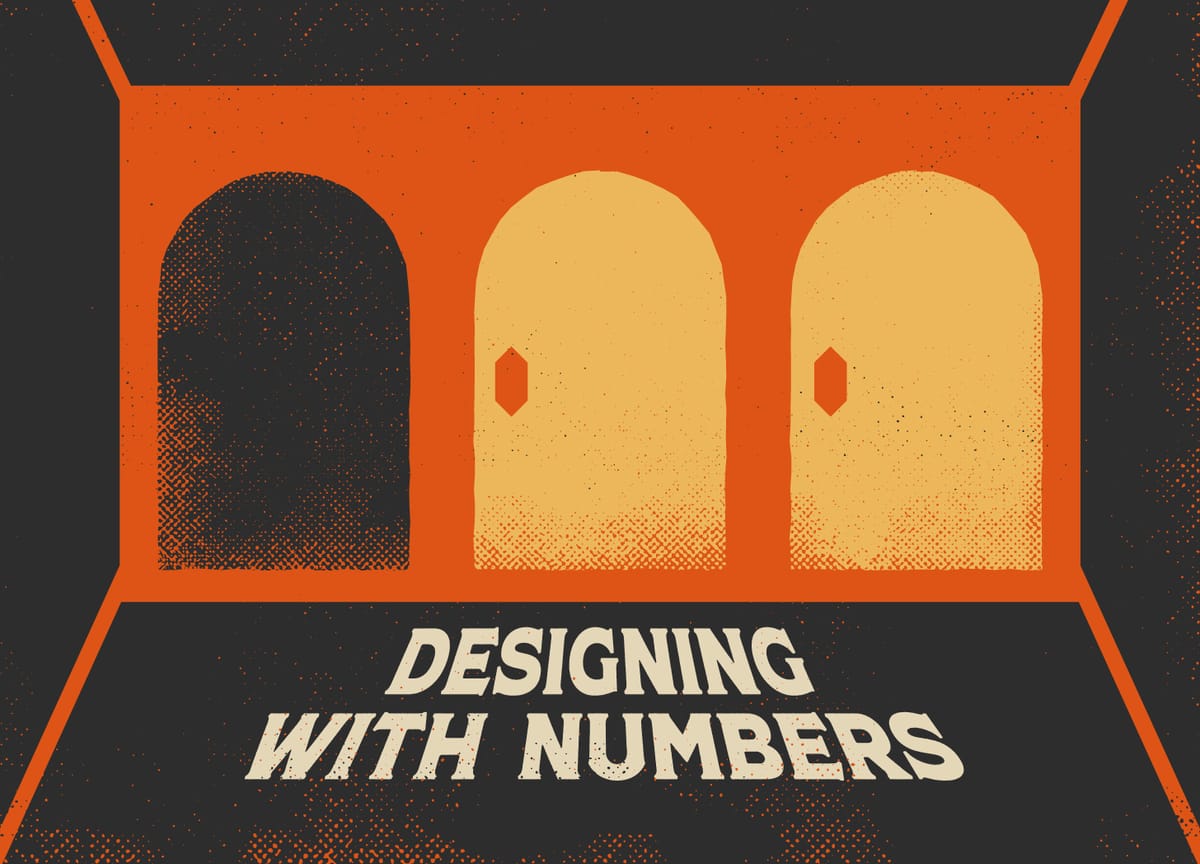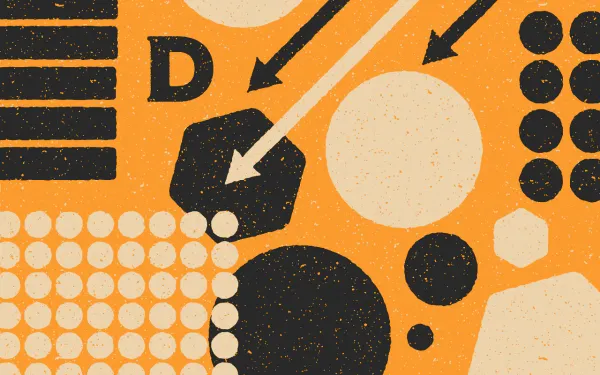Design the Dungeon with Numbers
How to leverage numbers in your roleplaying game designs.

The power of numbers.
Numbers have meaning. Those meanings are largely observed, learned, and fabricated—but they still have meaning. Let’s get it all out right now: I don’t believe in mystical numbers. The number three isn’t any more spiritual than forty-two. Numbers aren’t magic, because magic isn’t real. To quote a historian, though, we can't ignore magic when discussing human actions. Magic isn’t real, but its impact on human perception is as real as anything.
In roleplaying games, numbers are mostly derived from dice. But this article isn’t about picking the right dice for your loot tables. This is about the other numbers we take for granted. How many factions are in the campaign? How many doors are in this room? How many options are available to the player at any given moment?
The number we choose says something. Religion, science, and media have given us a relationship to numbers, and we can copy-and-paste that relationship on to other experiences.
In roleplaying games, these cognitive biases, assumptions, and tropes reinforce our gameplay, assist the players, and create intuitive experiences.
How to use numbers in design.
The higher the number, the less universal the relationships become. Across the globe, one through five is fairly universal. After that, you get into specific histories, religions, regions, and cultures. For example, seven is a magical number—whatever that means—to a lot of cultures, but to most modern cultures, it’s just two more than five and nothing more. Some cultures place powerful meaning on twelve. Certain film buffs love the number twenty-three. And if you’re a hoopy frood, you know that forty-two is the answer to everything.
For the sake of this article, we’re going to focus on numbers one through five.
Imagine a dungeon room. It’s fifty feet long, wide, and tall. In this room, there are doors. These doors are identical, atom-for-atom.
One door.
One is singular, indivisible, sometimes anomalous, and always monumental. If there is one door, whatever’s behind it is important (or at least inevitable). We know this intuitively. One door in video games is often secret. If it’s not secret, it’s before the boss battle. In religion, when there’s one god, it’s the god or your god. And in fiction, one thing is usually the main thing. The bad guy, the hero, or the MacGuffin.
- Doors. One signals a checkpoint, focal point, or funnel. Use it to trigger a pause, re-combine the party, regroup the players, or foreshadow something ahead.
- Characters. One character, faction, or foe is assumed to be unique, important, or both. Reduce your npcs, monsters, and factions down to one when you want the players to observe them, focus on them, or remember them. One bad guy can be a tutorial, a boss battle, or an anomaly—they shouldn’t be boring or arbitrary.
- Treasure. One thing by itself suggests a powerful thing or a punchline. It can be the sword in the stone or a single shoe in the center of a ravaged village. If you want players to investigate an item further, signal early that it is by its lonesome in some way. You can also subvert this expectation by putting an otherwise notable object in with others. The players will be less likely to notice it if it’s treated as one of many.
Two doors.
Two is a pair, a duality, binary, or complimentary grouping. If there are two doors, the choice is assumed to be opposing. In stories, this is the light and dark side of The Force, the unlikely duo, or the will-they-won’t-they couple. In mythology it’s the war between good and evil, chaos and order, life and death.
- Doors. Two doors suggest different or connected outcomes. The stealthy way and the loud way. The skill challenges hallway and the hallway with a brute. It’s important to remember that balance is also expected, at least in a lot of popular media. Unless of course you’re running a funhouse dungeon, which uses two doors like a binary for laughs and clear yes-no gamification.
- Characters. Two characters, enemies, or factions are assumed to be dueling opposites or complimentary halves. It’s simple to concieve and easy to act on. Two monsters in the same room should combo, be hurt by the other, or made weaker when separated. Two npcs are immediately more evocative when they can be pit against each other or compromised through the other.
- Treasure. In fiction, two objects often work better as a pair or cancel out each other. It’s probably the easiest trope to riff on. What I find more compelling is how using two suggests more through juxtaposition. For example, an olive branch is part of a plant until it’s compared to a sword or arrows.
Three doors.
Three is essential, important, and irreducible. If there are three doors, players often think they have three clear and distinct options. In real life and media, three is the love triangle, the Holy Trinity, three MacGuffins that destroy the world, or “the good, the bad, and the ugly.”
- Doors. Three is the base number that presents options without suggesting too much. There could be something remarkable behind that third door, but its not certain until someone pulls on the handle. I like to think of three as the default number of options to present. Three is easy to keep in one’s working memory and suggests diversity of options.
- Characters. Three characters, monsters, or factions creates of narrative balance. Three monsters retain their strength and identity as individuals while still forming a cohesive group. Three factions flesh out a world by suggesting more than a duality or singular theme.
- Treasure. Three items in a room are perceived as multiple in the normal sense. They can be mundane or important. Its not out of place to assume either.
Four doors.
Four is a complete and well-rounded group. Four forms a small council, cornerstones of an institution, or the four elements of nature. In fiction, four can be warring nations, lieutenants of a big bad, or pieces of a puzzle.
- Doors. Four is a lot of doors. Players will be inclined to subdivide them into pairs or separate one from the others. That’s the power of four. It feels like many but is still divisible. Present four doors or options when you want to present a sandbox with real or easy to fabricate boundaries.
- Characters. Four characters, monsters, or factions is the first number that feels like an amorphous plural. Four is your smallest unit of ready-to-roll orcs, goblins, or stormtroopers. A campaign with four factions suggests an alliance, a wild card, and one overpowered group.
- Treasure. Piles of treasure start at four. In D&D, four can be split evenly between your classic adventuring party. Four also presents the opportunity to stuff a room with a mix of mundane and notable treasures.
Five or more doors.
Five is many, diverse, and suggests complete freedom. Once there are five or more things, players prioritize and forget or discard (intentionally or not) certain elements depending on the complexity. Five can be rearranged and subdivided into many combinations, often too many without tools.
We don’t see groups of five in movies, unless its an ensemble, a montage, or a culmination of the narrative. In games, your stats and classes usually start at five or more. In sandbox games, five sidequests are normal, five places to be is when you’re well and truly cooking with gas. The sheer scale and complexity of five or more, is usually why it’s being used at all.
- Doors. Five or more doors are the stuff of mega-dungeons. On an overland map, they’re the six directions presented by a hex grid. Present five or more doors when you want players to feel like they’re being given the freedom to explore without explicit objectives or goals. Create implied categories. Make those categories overlap for added texture and depth.
- Characters. Five characters, monsters, or factions is when you finally have “a lot.” For big campaigns, five or more of anything is how you suggest depth and verisimilitude. In combat, five baddies is a fight between groups, usually with minions and other types, like a spellcaster, healer, or boss. Five factions, meanwhile, is when a world starts to feel complex and lived-in instead of staged or metaphorical. For example, in Star Wars, there are only two major factions. It’s about the war between good and evil. In Game of Thrones, there are many factions because it’s largely about intrigue and chaos.
- Treasure. Five or more items is the start of a treasure hoard. It all depends on how the items are depicted. Without proper descriptions, it’s easy for important objects to get filed under miscellaneous sundries.
Too many doors! A common problem.
When I read through a game, scenario, or dungeon—I can’t help but look at the plurality of things. How many branching paths? How many attributes? How many bad guys?
A lot of storytelling is being left on the table. Or worse, the number of things is too high. There’s a psychological idea in design called Miller’s Law, which states that the average person can hold 7 (plus or minus 2) things in their working memory.
In tabletop roleplaying games, that number is probably even fewer, because those things are often abstracted, interpreted, and held in the collective imagination of everyone at the table. They’re not color-coded buttons on a physical control panel. Heck, if the room is described poorly, the players might not be able to even identity what the choices are.
That’s why I think most RPGs should lean toward fewer groupings or strongly consider the design from a user-friendly perspective.
The number of things can be, in effect, decreased or expanded using techniques like “chunking” or lampshading. The user/adventurer could then, given reasonable assumption, reduce any number of options to something fewer and more relevant to them.
An example:
We want a central hub in a mega-dungeon with six doors. Think of this setting as your typical high-fantasy dungeon. How do we make these six doors more manageable?
Step 1: Chunk it out!
- We’ll make one door huge and put it in the center of the room. Now, it’s a subgroup within the group. Players will treat this door as The Door.
- We’ll flank the big door with two doors on each side. These are now two dueling pairs of doors. Another subgroup within the grouping. Players will think of these four doors as being in the same category in some way.
- We’ll add the last door off to the side. We’ll make it small—maybe even secret—and make it now an “alternative” door to all the other doors.
Step 2: Lampshade it!
- We’ll put a big ole skull on the huge door. Now, the players will suspect danger. They might save it for later, especially since a big skull door usually screams, “Boss fight!”
- We’ll cover two of the four doors with religious iconography, which should make them stand out to the paladins and clerics in the group. Then, we’ll make the sound of orcs sleeping come from the other two doors so that rogues and fighting types feel incentivized. By doing this to both doors, we effectively lower the number of options based on the group’s makeup—or create pointed conversation.
- We’ll let the sixth secret door go unnoticed. Player characters who want to find secrets will find it. If decision making stalls, encourage them to investigate the room—then add this door to the options. Secret doors almost always beat non-secret doors.
Why the number matters.
Plurality in your work says something, and design is about saying things purposefully. The breakdown above shouldn’t limit your ideas, but it should influence them.
In the sentence, “There are two doors. One is big and ornate, and the other is small and humble.” The storytelling doesn’t start with the description of the doors. It starts when you say there are two.
Use numbers to tell stories and change play. They can reward players or surprise them. They can make choices easy or complicated. When you know how much your design matters, you can control why.
Never stop exploring.




